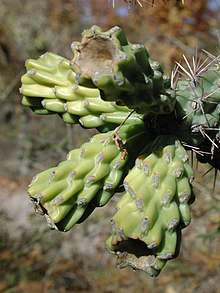Cylindropuntia spinosior
Cylindropuntia spinosior, with the common names include cane cholla, spiny cholla and walkingstick cactus, is a cactus species of the North American deserts.
| Cylindropuntia spinosior | |
|---|---|
 | |
| Immature fruits on a plant in Gila County, Arizona | |
| Scientific classification | |
| Kingdom: | Plantae |
| Clade: | Tracheophytes |
| Clade: | Angiosperms |
| Clade: | Eudicots |
| Order: | Caryophyllales |
| Family: | Cactaceae |
| Genus: | Cylindropuntia |
| Species: | C. spinosior |
| Binomial name | |
| Cylindropuntia spinosior | |
| Synonyms | |
| |
It is native to Arizona and New Mexico in the United States; and Chihuahua and Sonora in Mexico.[1]
Description
Cylindropuntia spinosior grows to between 0.4 and 1.2 metres in height and has spine-covered stems. Flowers may be rose, red purple, yellow, or white and appear from spring to early summer. These are followed by fruits that are yellow with occasional red or purple tinges.[2]
Invasive species
In Australia, the species is regarded as an emerging weed threat in Queensland where it is known as snake cactus.[3] It is a declared noxious weed in New South Wales where it was first observed to be naturalised in 2000/2001.[2][4] It is also naturalised in South Australia.[4]
References
- "Cylindropuntia spinosior". Germplasm Resources Information Network (GRIN). Agricultural Research Service (ARS), United States Department of Agriculture (USDA). Retrieved 20 May 2012.
- "Cylindropuntia spinosior (Engelm.) F.M.Knuth". PlantNET - New South Wales Flora Online. Royal Botanic Gardens & Domain Trust, Sydney Australia. Retrieved 20 May 2012.
- "Snake cactus". Agriculture, Fisheries and Forestry (Queensland Government. Archived from the original on 5 April 2011. Retrieved 20 May 2012.
- "Cylindropuntia spinosior". Australian Plant Name Index (APNI), IBIS database. Centre for Plant Biodiversity Research, Australian Government, Canberra. Retrieved 20 May 2012.
External links
- Cylindropuntia spinosior photo gallery at Cholla Web
- Flora of North America @ efloras.org: Cylindropuntia spinosior
| Wikimedia Commons has media related to Cylindropuntia spinosior. |